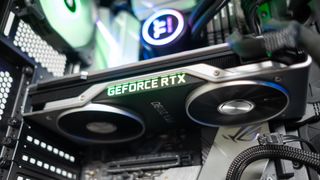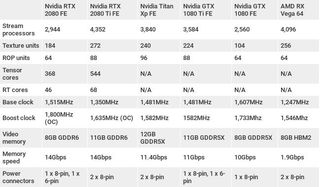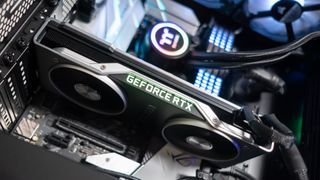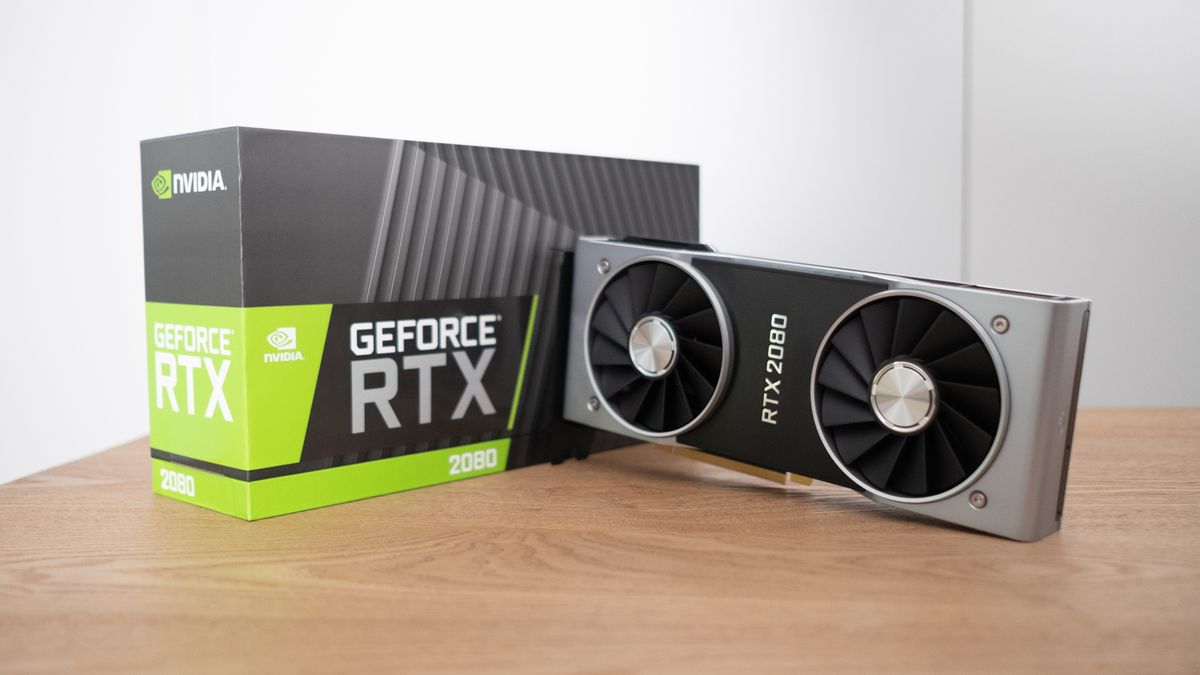TechRadar Verdict
It doesn't reach the heights of the RTX 2080 Ti, but Nvidia’s high-end Turing RTX GPU comes damn close to achieving 4K 60fps gaming for a mildly steep price.
Pros
- +
Impressively improved gaming frame rates
- +
The second most performant GPU in the world
- +
Super simple overclocking
Cons
- -
Nvidia’s most expensive xx80 card yet
- -
Dips under 60 fps with some 4K games
- -
More power demanding
Why you can trust TechRadar
The Nvidia GeForce RTX 2080 may no longer be the flagship GPU du jour, with RTX 3080 just announced at Nvidia’s September 1 event. However, it still very much holds its own in a souped up gaming rig, and is one of the most powerful gaming cards, especially in the RTX line.
This Turing card’s performance still justifies its relatively high price and is only slightly limited next to its more powerful siblings and rivals on our best graphics cards list. So, unless you need 4K 60fps performance, you can skip the RTX 2080 Ti for the Nvidia GeForce RTX 2080.
And, while the GPU has been discontinued in favor of its refreshed successor, the RTX 2080 Super, it’s still available through some retailers. In fact, with the RTX 3000 slated for release on September 17, you can probably expect some deals on the RTX 2080’s floating around.
Pricing and availability
Just when we were getting over the $549 (£469, AU$925) Nvidia GTX 1080 being noticeably more expensive than its predecessor, the Nvidia RTX 2080 hit the streets with an even higher $799 (£749, AU$1,199) price.
Bear in mind this is the price of Nvidia RTX 2080 Founders Edition, which are high-end versions of Nvidia’s GPUs, and it’s also slightly dropped in price, now setting you back $719 (about £570, AU$1030). Additionally, you’ll find third-party models that start at a slightly lower $699 (£749, AU$1,199) price.

Still, the Nvidia GeForce RTX 2080 gets yet another massive increase in price over previous generations of graphics cards. It wasn’t that long ago when the GTX 1080 Ti cost just as much at $699 (£669, AU$1,129). With this latest series of Nvidia GeForce graphics cards, it seems Team Green is trying to up the cost of its graphics cards to be more premium than in prior years.
If you’re seeking a high end graphics card that’ll cost less than $500, you’re stuck with the $399 (about 320, AU$570) Radeon RX Vega 64. AMD’s highest-end Vega graphics card is getting long in the tooth after a year. It’s also worth noting that the Team Red is gearing up to unleash its AMD Navi cards, which have a couple of under $500 options.
However, the Nvidia GeForce RTX 2080 is everywhere, with plenty of stock in most online stores. In fact, there are so many of them out there that you can expect some deals.

Specifications and features
Spec for spec, the RTX 2080 is a step up from its predecessors in every way, packing more CUDA cores, faster GDDR6 video memory and even the first very 90Mhz factory overclock on Nvidia’s Founders Edition cards.
Additionally, the Nvidia GeForce RTX 2080 introduces a new set of 46 RT Cores and 468 Tensor Cores, which play a hand in rendering real-time ray tracing and artificial intelligence-powered computations.
Both features are unique to Nvidia’s latest graphics cards, but you’ll probably notice the immediate effects RT Cores and Nvidia RTX brings as it transforms puddles, glass and other reflective surfaces into mirrors for the first time in video games.
Tensor Cores are also impressive too. By introducing AI into mainstream graphics cards, Nvidia claims all Turing-based GPUs will be able to process anti-aliasing eight times faster. The RTX 2080 can also tap into a new Deep Learning Super Sampling feature that’s much more efficient at applying super sampling and anti-aliasing at the same time.
Those AI-injected Tensor Cores are also pivotal for Nvidia’s new super-simple overclocking features.
Popular overclocking apps like EVGA Precision X1 and MSI Afterburner have released beta builds that integrate this new NV Scanner API, which essentially tweaks your GPU up a precise micro-voltage curve and tests for stable overclock speeds and voltages.
The new test basically takes out all the guesswork out of maximizing the performance of your GPU, and it's one of the unique features we love about the new Turing series.








CPU: 3.7Ghz Intel Core i7-8700K (hexa-core, 12MB cache, up to 4.7GHz)
RAM: 32GB Vengeance LED DDR4 (3,200MHz)
Motherboard: Asus ROG Strix Z370-E Gaming
Power Supply: Corsiar RM850x
Storage: 512GB Samsung 960 Pro M.2 SSD (NVMe PCIe 3.0 x4)
Cooling: Thermaltake Floe Riing 360 TT Premium Edition
Case: Corsair Crystal Series 570X RGB
Operating system: Windows 10
Performance
The Nvidia GeForce RTX 2080 is, without a doubt, more expensive than its predecessor. Luckily, it is powerful enough to make the price bump less egregious. The new GPU is a considerably better performer than the GTX 1080 with remarkably higher benchmark scores that even beat the GTX 1080 Ti and Titan Xp.
The RTX 2080 isn’t quite as powerful as the RTX 2080 Ti, but you won’t find any other mainstream graphics cards as powerful as the 2080.
In games, you’ll witness an even bigger jump in performance if you choose to pick up this new RTX graphics card. 1080p gaming results show a 20-40 fps jump in frame rates. Meanwhile, at 4K the Nvidia RTX 2080 is hitting as high as 60 fps, and that’s damn impressive.




Outside of our benchmark tests, the Nvidia RTX 2080 also managed to achieve 40 fps while playing Shadow of the Tomb Raider at 4K and the highest settings available. Destiny 2 delivered even better numbers with a frame rate hovering between 60-75 fps, once again at 4K and Ultra settings, not to mention HDR turned on.

Final verdict
If you’re prepared to hand over the kingly sum of $719 (about £570, AU$1030) that this graphics card demands, you won’t come away disappointed. Other than the Nvidia RTX 2080 Ti, there isn’t another graphics card faster than this currently, or one that could possibly deliver a 4K 60 fps gaming experience all on its own.
But even then, the RTX 2080 is cutting it close to delivering that sacred, silky-smooth frame rate at Ultra-HD resolutions. If you don’t want to deal with compromises, toning down your settings and splurging even more, you’d be much better off going with the top-end Nvidia RTX 2080 Ti.
We’d personally go for the Nvidia RTX 2080 as its still hitting that sweet spot of performance to price, even if you have to save up a little more or swallow an extra credit card payment to pay it off.
First reviewed September 2018
Image credit: TechRadar
Kevin Lee was a former computing reporter at TechRadar. Kevin is now the SEO Updates Editor at IGN based in New York. He handles all of the best of tech buying guides while also dipping his hand in the entertainment and games evergreen content. Kevin has over eight years of experience in the tech and games publications with previous bylines at Polygon, PC World, and more. Outside of work, Kevin is major movie buff of cult and bad films. He also regularly plays flight & space sim and racing games. IRL he's a fan of archery, axe throwing, and board games.

ESR Qi2 3-in-1 Watch Wireless Charging Set (HaloLock) review: it's fast charging and compact, but that neck doesn't bend

Is this 4K projector inspired by turtles? Fujifilm's latest UST projector has a folded rotatable popup lens

New info about Sonos' streaming box sounds like a dream product, apart from the 2 horrendous flaws
Most Popular




